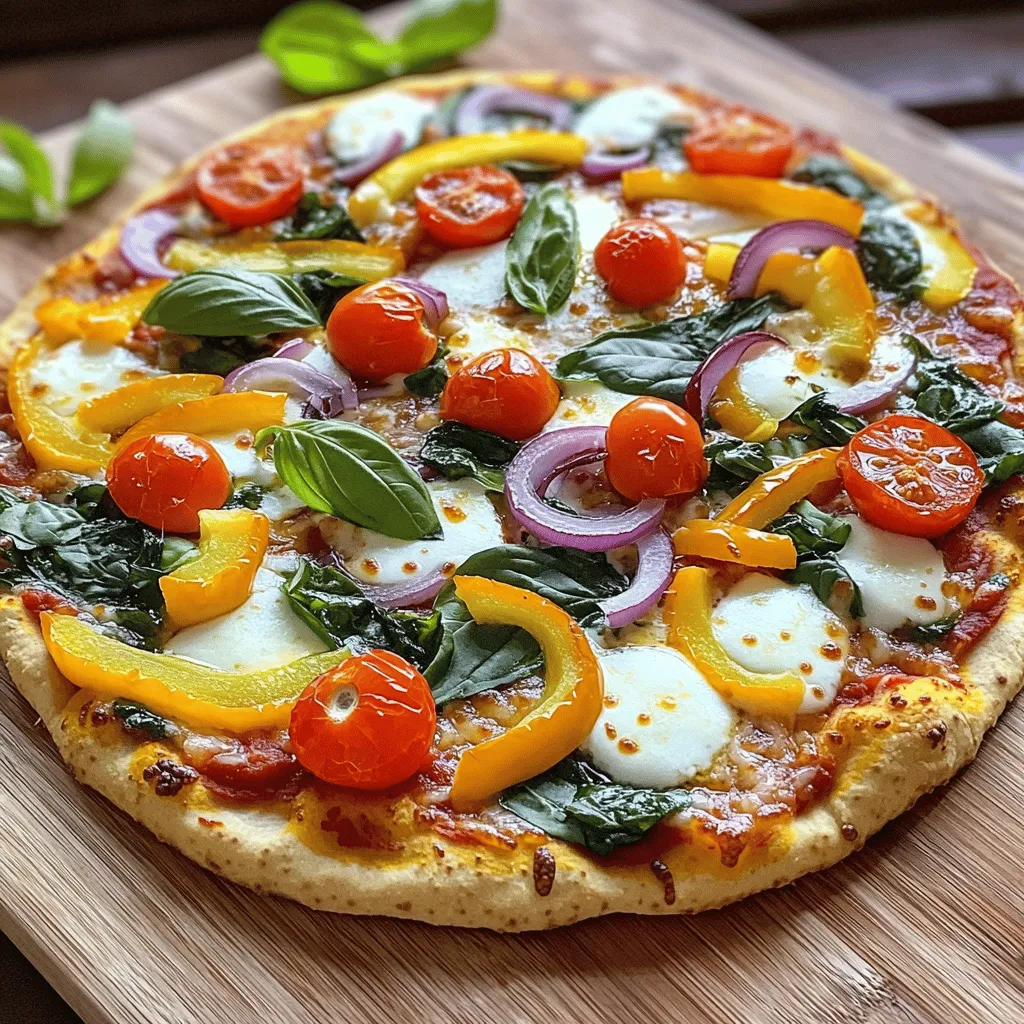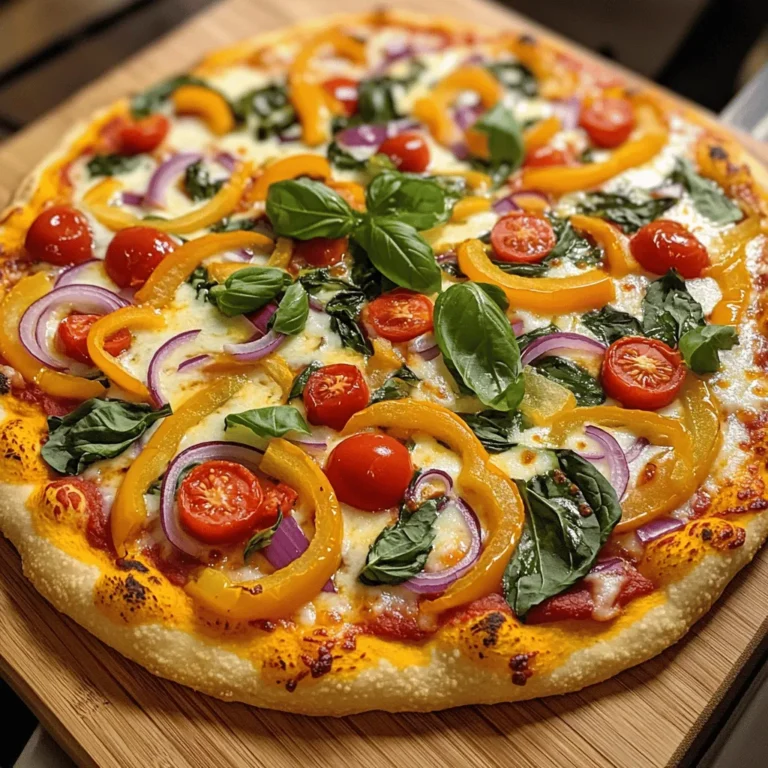Ready to enjoy a delicious Loaded Veggie Pizza that bursts with flavor? This recipe is your perfect guide to creating a homemade delight that will satisfy your taste buds and nourish your body. Packed with fresh veggies and gooey cheese, it’s simple and fun to make. Whether you’re a pizza pro or a kitchen newbie, I’ll walk you through each step to whip up this colorful, tasty meal. Let’s dive into the good stuff!
Ingredients
To make a loaded veggie pizza, you need a few key ingredients. Here’s what you should gather:
– Pre-made pizza crust
– Pizza sauce or marinara
– Shredded mozzarella cheese
– Fresh vegetables:
– Bell peppers
– Red onion
– Spinach
– Mushrooms
– Black olives
– Cherry tomatoes
– Seasonings:
– Dried oregano
– Garlic powder
– Red pepper flakes
These ingredients create a pizza full of flavor and color. The pre-made crust saves time while still offering a crispy base. Pizza sauce or marinara adds a rich, tangy layer. Shredded mozzarella cheese gives that gooey, cheesy goodness.
Fresh vegetables not only add nutrients but also texture. Bell peppers bring crunch, while spinach adds a fresh taste. Mushrooms contribute a nice earthiness, and black olives add a salty bite. Cherry tomatoes burst with sweetness.
Seasonings elevate the flavors. Dried oregano and garlic powder enhance the taste, while red pepper flakes add a kick.
Step-by-Step Instructions
Initial Preparation
1. Preheat the oven to 475°F (246°C). This will help the crust get nice and crispy.
2. Prepare your baking surface by placing the pre-made pizza crust on a baking sheet or pizza stone. You can brush the crust with olive oil for extra flavor if you want.
Assembling the Pizza
1. Spread the pizza sauce evenly over the crust. Leave a little space around the edges to form a crust.
2. Sprinkle half of the shredded mozzarella cheese over the sauce. This helps hold the toppings in place.
3. Layer the sliced bell peppers, red onion, mushrooms, spinach, black olives, and cherry tomatoes across the pizza. Spread them out evenly.
4. Season the pizza with garlic powder, dried oregano, and red pepper flakes for a little heat if you like.
5. Add the remaining mozzarella cheese on top to cover the veggies well.
Baking the Pizza
1. Place the pizza in the preheated oven. Bake for 12-15 minutes. Keep an eye on it until the cheese is bubbly and golden brown.
2. Once done, take it out and let it cool for a couple of minutes. Garnish with fresh basil leaves.
3. Slice the pizza into wedges and serve hot. Enjoy the burst of flavors!
Tips & Tricks
Perfecting Your Crust
To get a crispy crust, you need high heat. Preheat your oven to 475°F (246°C). This helps the crust cook fast. A pizza stone works great for heat retention. If you use a baking sheet, brush it lightly with oil. This gives the crust a nice crunch. You can choose a store-bought crust or make your own. For homemade, use flour, water, yeast, and salt. Let it rise for a fluffy texture.
Cheese Options
Mozzarella is the best cheese for loaded veggie pizza. It melts well and has a mild taste. You can also mix in provolone for extra flavor. If you want a twist, try goat cheese or feta. For a vegan option, use cashew cheese or almond-based cheese. These alternatives melt nicely and add creaminess.
Enhancing Flavor
Herbs and spices make your pizza shine. Dried oregano and garlic powder are classic choices. You can also add fresh basil after baking. For more heat, sprinkle red pepper flakes. Want more veggies? Top your pizza with artichokes, zucchini, or eggplant. Each adds a unique taste and texture. Mix and match to find your favorite combos!

Variations
Gluten-Free Loaded Veggie Pizza
You can easily make a gluten-free version. Use gluten-free pizza crusts made from rice flour or almond flour. You can also try a cauliflower crust for a fun twist. When making your pizza, check the labels on sauces and cheese. They should be gluten-free as well.
For cooking tips, bake the pizza on a pizza stone. This helps the crust turn crispy. Preheat your oven to 475°F (246°C) just like the regular pizza. Keep an eye on the pizza while it bakes. Gluten-free crusts can cook faster.
Vegan Loaded Veggie Pizza
To make a vegan loaded veggie pizza, swap out the cheese for dairy-free options. Brands like Daiya or Violife offer great choices. For the sauce, use a plant-based version or make your own with tomatoes and herbs.
You can add more veggies too! Try artichokes, zucchini, or even eggplant. These add color and taste. Toss in some fresh herbs like basil or cilantro for extra flavor.
Seasonal Varieties
Using seasonal vegetables makes your pizza fresh and tasty. In spring, add asparagus and fresh peas. Summer is perfect for ripe tomatoes and zucchini. In fall, use roasted butternut squash or Brussels sprouts. Winter calls for hearty veggies like kale or root vegetables.
For a holiday-themed pizza, think about fun shapes. Use cookie cutters to create festive veggie toppings. You can also add seasonal spices like nutmeg or cinnamon for a unique twist.
Storage Info
Storing Leftovers
After enjoying your loaded veggie pizza, let it cool first. Cooling helps prevent sogginess. Place the leftovers in an airtight container. You can use a glass or plastic container. Make sure to seal it tightly. Store it in the fridge. Leftovers will stay fresh for about three to four days.
Reheating Guidelines
To reheat your pizza, use an oven for the best results. Preheat the oven to 375°F (190°C). Place the pizza slices directly on the oven rack. This keeps the crust crispy. Heat for about 10 minutes. You can also use a skillet on the stove. Heat on low, covering the pan to warm the toppings. This method also helps keep the crust nice.
Freezing Options
To freeze loaded veggie pizza, slice it into pieces. Wrap each slice tightly in plastic wrap. Place wrapped slices in a freezer bag. Squeeze out any air before sealing. The pizza can last up to two months in the freezer. When you’re ready to eat, take out a slice. Thaw it in the fridge overnight. Reheat it in the oven or skillet as mentioned above. Enjoy your frozen pizza just like fresh!
FAQs
What can I substitute for pizza sauce?
You can use several options for pizza sauce. Try using marinara sauce, pesto, or even hummus. Each gives a unique flavor. If you want to make a homemade sauce, blend canned tomatoes, garlic, and herbs. This adds a fresh taste and is easy to create.
How do I make my loaded veggie pizza spicier?
To add spice, sprinkle red pepper flakes on top. You can also use spicy toppings like jalapeños or pepperoncini. Another option is to mix hot sauce into your pizza sauce. This boosts the heat and gives a nice kick.
Can I use different vegetables?
Absolutely! You can customize the veggies on your pizza. Some great options are zucchini, artichokes, or broccoli. You want to choose firm vegetables. They hold their shape well during baking. Feel free to mix and match your favorites!
You can now make your own loaded veggie pizza at home. We covered the key ingredients, step-by-step instructions, and helpful tips. You learned how to perfect your crust and choose the best cheeses. We also explored variations for gluten-free and vegan options, plus storage and reheating tricks.
Making pizza allows for creativity and fun in the kitchen. Enjoy experimenting with flavors and toppings. This is a great way to share delicious meals with family and friends. Now, it’s time to gather your ingredients and start your pizza adventure!


